Was he an eccentric madman or a misunderstood genius? Either way, Vincent van Gogh (1853-1890) left behind a collection of art that he couldn’t have imagined would ever become so famous.
While many other painters and artists in history became rich during their lifetime, van Gogh only managed to sell one painting. Today, his paintings are some of the most valuable in the world.
The life of the Dutch artist was defined by depression, poverty, and psychotic episodes, which eventually culminated in his suicide in the year 1890.
Despite his many issues and the fact that he only picked up painting less than a decade before his death, he managed to create over 2,100 pieces of art of which about 900 were oil paintings.
Let’s take a closer look at the top 17 most famous Vincent van Gogh paintings so you get a clear view as to why his oeuvre has been admired by millions around the world and why he’s considered to be one of the most famous Post-Impressionist artists in history.
1. The Starry Night
- Date created: 1889
- Location: The Museum of Modern Art, New York City, United States
- Dimensions: 73.7 × 92.1 centimeters – 28.7 × 36.25 inches
The Starry Night was painted in June 1889 in the asylum that van Gogh voluntarily stayed in Saint-Rémy-de-Provence in southern France. He had entered the Saint-Paul-de-Mausole asylum on May 8, 1889. This was 6 months after his psychotic episode in Arles in which he cut off part of his own ear. It’s one of his most famous paintings and has been regarded as one of his finest paintings.
This oil painting depicts the view that van Gogh had out of his asylum room facing the east side. The painter used variations of this view over 20 times and most probably painted from memory. His studio in the asylum was located on the ground floor. He also mentioned in a letter to his brother that his window had iron bars that obscured his view.
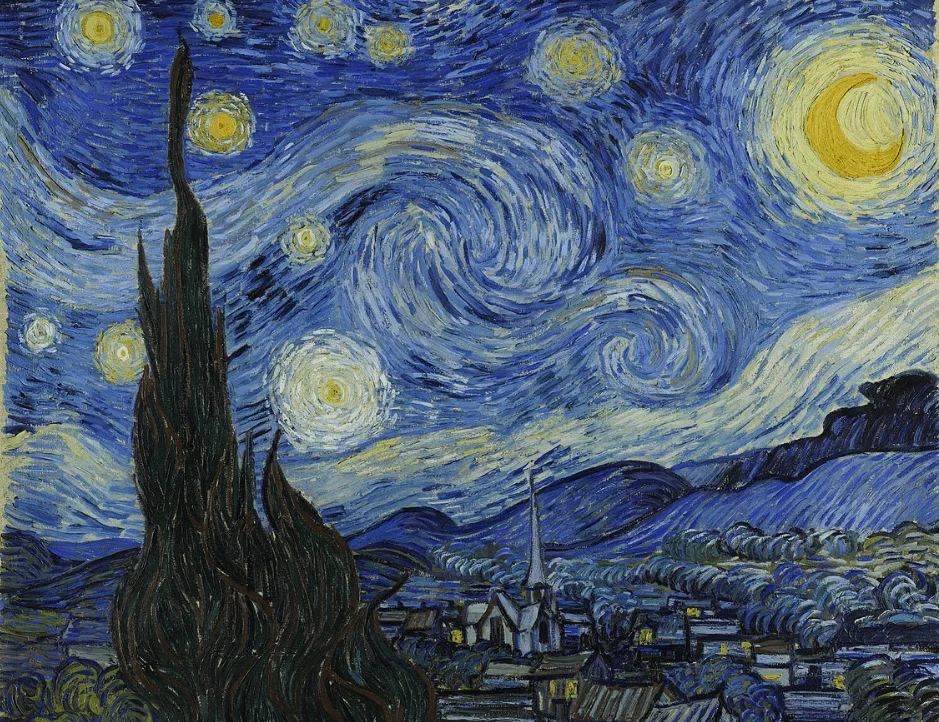
2. Sunflowers
- Date created: 1888
- Location: National Gallery, London, United Kingdom
- Dimensions: 95 × 73 centimeters – 37 x 29 inches
Sunflowers is the name of a series of paintings with the same theme. The first part of the series was created when the painter was staying in Paris in 1887 and the second series was painted during his stay in Arles in 1888.
The first series depicts the flowers lying down, while the second series depicts the flowers as a bouquet standing in a vase. Van Gogh painted the second series in an attempt to impress fellow artist Paul Gauguin who he was expecting for a visit.
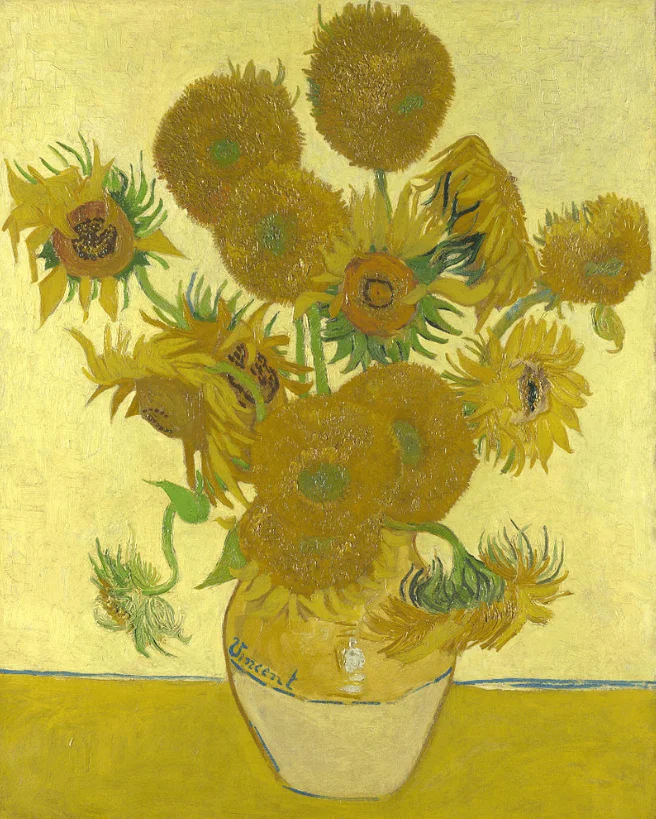
3. Self-Portrait of van Gogh
- Date created: 1889
- Location: Musée d’Orsay, Paris, France
- Dimensions: 65 × 54 centimeters – 26 × 21 inches
Vincent van Gogh created over 35 self-portraits in his lifetime, and this one is most probably the last he ever created. He painted it in September 1889, a time that he was a patient at the asylum in Saint-Rémy-de-Provence in southern France.
This self-portrait of van Gogh depicts the state of mind of the artist which is clearly not good. Less than a year after creating this self-portrait, he would point a loaded gun at his chest and pull the trigger, leading to his death a few days later.

4. The Potato Eaters
- Date created: 1885
- Location: Van Gogh Museum, Amsterdam, Netherlands
- Dimensions: 82 × 114 centimeters – 32.3 × 44.9 inches
The Potato Eaters is a painting created by van Gogh during his time in Nuenen, Netherlands, in April 1885. When he lived in Paris 2 years later, he identified this as the best painting he ever created.
The painter came from an upper-middle-class family and tried to identify with peasants as they are having dinner. He depicted the harsh life of people living a working-class life.
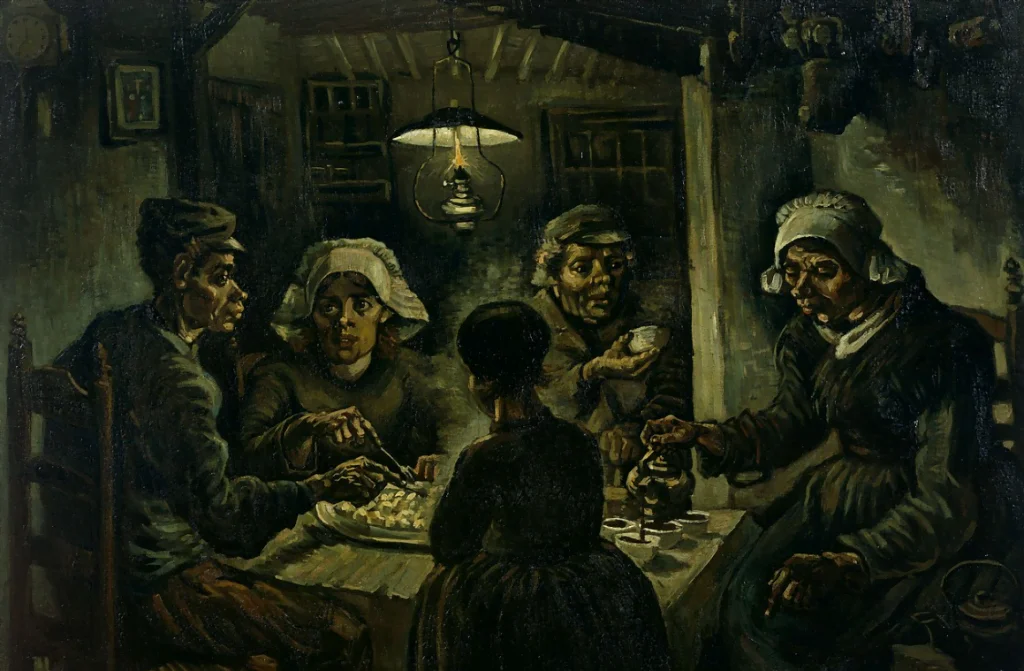
5. Starry Night over the Rhône
- Date created: 1888
- Location: Musée d’Orsay, Paris, France
- Dimensions: 72.5 × 92 centimeters – 28.5 × 36.2 inches
Starry Night over the Rhône is a painting depicting Arles at night in a location on the banks of the Rhône River, which was only a 2-minute walk from the Yellow House that he was renting at the time.
The night sky resembles that of his most famous work, The Starry Night, a background he used in multiple of his paintings. This painting gave van Gogh the inspiration to use the effects of light at night in multiple other of his paintings as well.
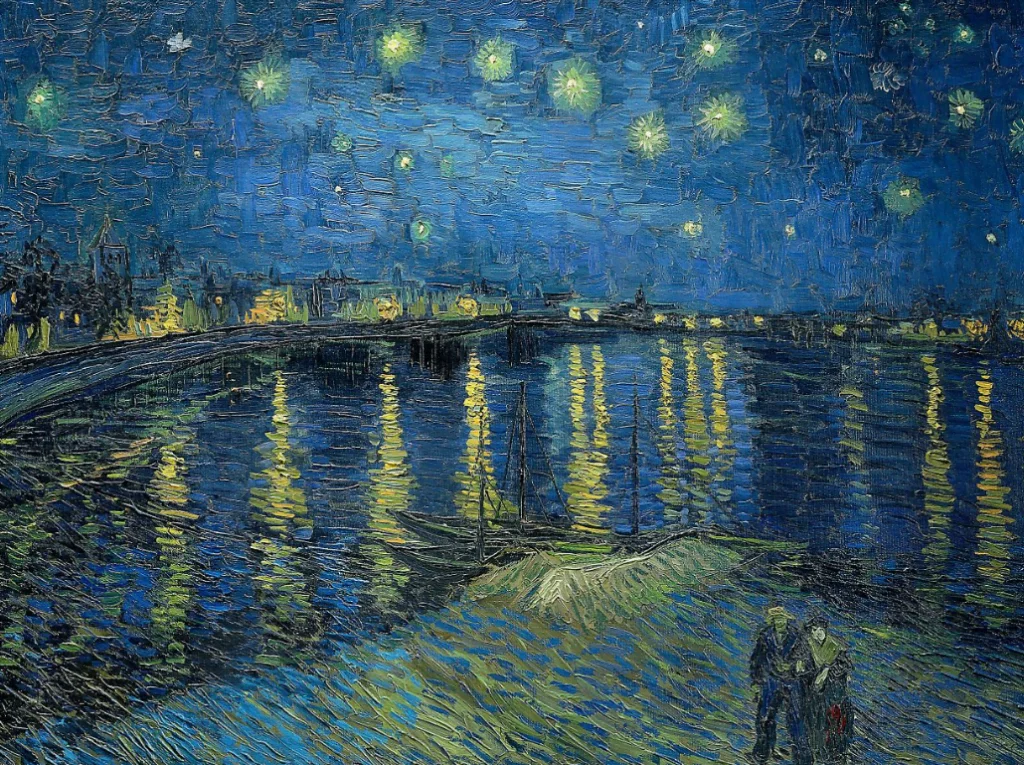
6. The Yellow House
- Date created: 1888
- Location: Van Gogh Museum, Amsterdam, Netherlands
- Dimensions: 76 × 94 centimeters – 28.3 × 36 inches
The Yellow House is also sometimes referred to as “The Street” and depicts the house that van Gogh was renting in Arles. He had his studio on the first floor, and the guest house, in which Paul Gauguin stayed for 9 weeks in 1888, was located on the first floor and has both shutters open.
On the left side of the painting, there’s a pink building, and van Gogh indicated that this was the restaurant he used to have his meals. The Yellow House was bombed severely during World War II and was later demolished.
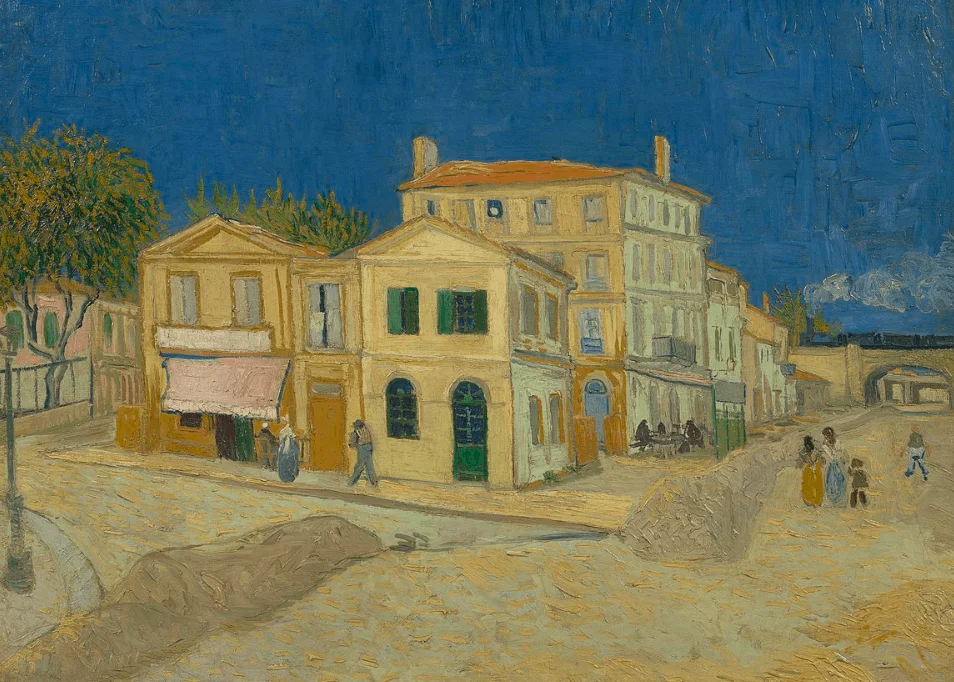
7. Café Terrace at Night
- Date created: 1888
- Location: Kröller-Müller Museum, Otterlo, Netherlands
- Dimensions: 80.7 × 65.3 centimeters – 31.8 × 25.7 inches
Café Terrace at Night is also known as “The Cafe Terrace on the Place du Forum” and was originally called “Coffeehouse, in the evening.” It depicts the northeastern corner of the “Place du Forum” in Arles and was painted in mid-September 1888.
Of all the paintings in which he used a starry background, this was the first one. This background became more prominent in his later works and was repeated multiple times. Van Gogh mentioned in one of his letters that he used to visit the Café depicted in the painting regularly.
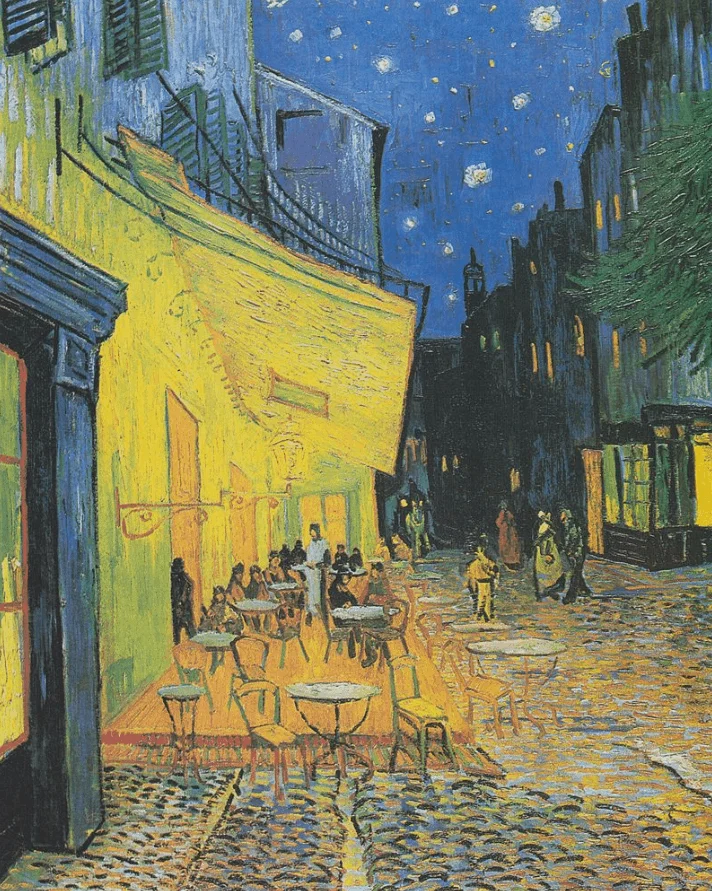
8. Portrait of Dr. Gachet
- Date created: 1890
- Location: Private collection
- Dimensions: 67 × 56 centimeters – 23.4 in × 22.0 inches
The Portrait of Dr. Gachet was painted shortly after van Gogh had left the asylum at Saint-Rémy-de-Provence. Paul Gachet was a homeopathic doctor who took care of van Gogh after he left the asylum, which ended up being the final months of his life.
He painted more than 70 paintings during his stay with Gachet, including the portraits he made of him. There are two versions of the portrait and the first version was sold in 1990 in an auction for USD 82.5 million to a private buyer. This is the equivalent of over USD 160 million today.
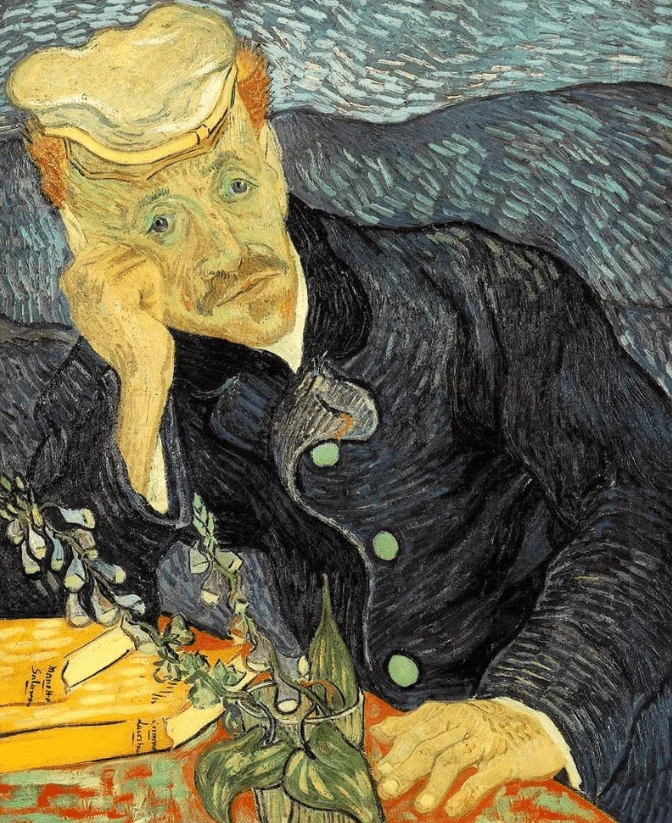
9. Irises
- Date created: 1889
- Location: J. Paul Getty Museum, Los Angeles, United States
- Dimensions: 71 × 93 centimeters – 28 × 36 inches
Irises is the name of another series of paintings that van Gogh made during his stay in the asylum in southern France. It was painted in May 1889, which was within a week after arriving at the institution.
The paintings depict irises that were growing in the hospital’s garden. Van Gogh described the paintings as “the lightning conductor for my illness,” referring to the fact that continuing to paint kept him from going completely mad. It’s considered to be one of the most expensive van Gogh paintings in the world.
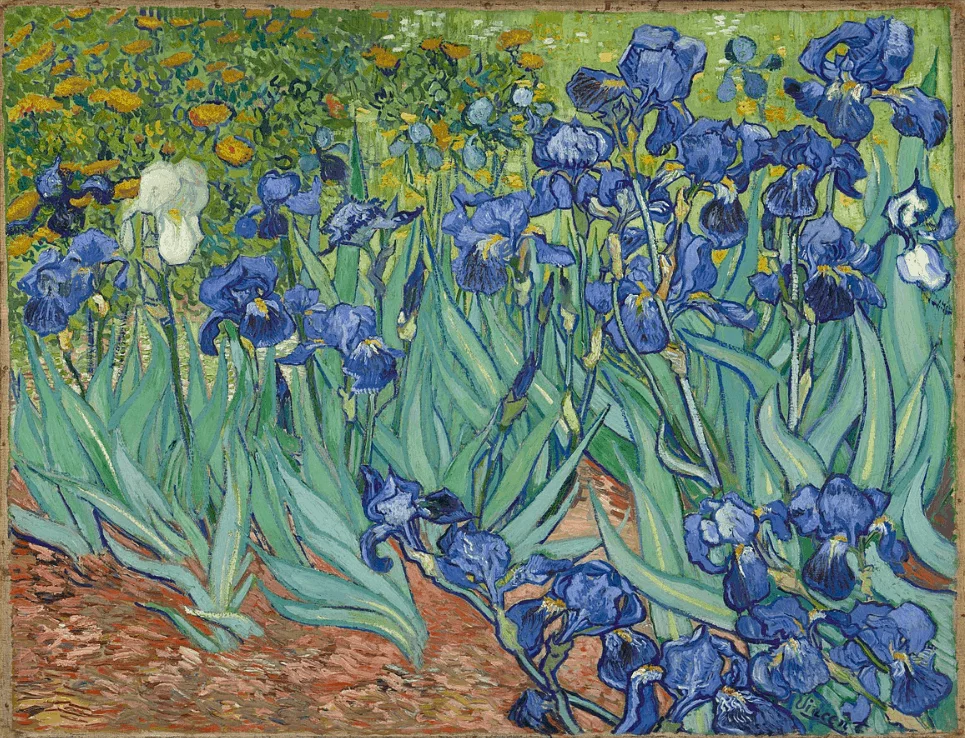
10. Wheatfield with Crows
- Date created: 1890
- Location: Van Gogh Museum, Amsterdam, Netherlands
- Dimensions: 50.2 × 103 centimeters – 19.8 × 41 inches
Wheatfield with Crows was painted in July of the year 1890, which is the month that van Gogh committed suicide. It has been described as one of his greatest works, and some historians claim it to be his final painting as well, even though there is no certainty about this fact.
It depicts a cloudy sky that is filled with crows flying over a wheatfield. There’s a path in the middle of the field which is leading to nowhere. Van Gogh wrote in a letter that this painting was expressing sadness and extreme loneliness, which is clearly the reason why he took his own life just a few weeks later.

11. The Red Vineyard
- Date created: 1888
- Location: The Pushkin State Museum of Fine Arts, Moscow, Russia
- Dimensions: 75 × 93 centimeters – 29.5 × 36.6 inches
The Red Vineyard is a painting created during van Gogh’s time in November 1888. It depicts people who are working in a vineyard near the city of Arles.
One of the most remarkable facts about this painting is that it is believed to be the only painting that was ever sold during van Gogh’s lifetime. It was bought by Anna Boch, another artist at the “Les XX, 1890“, in Brussels, Belgium. It eventually ended up in the collection of Sergei Shchukin, in Shchukin‘s home at Trubestkoy Palace in Moscow.
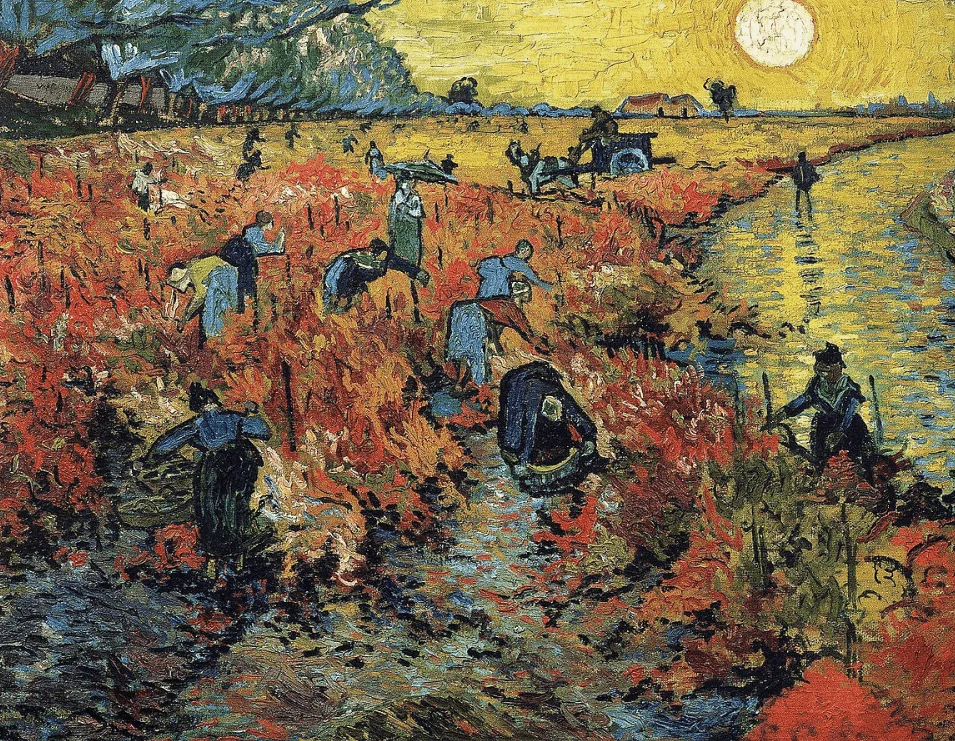
12. The Church at Auvers
- Date created: 1890
- Location: Musée d’Orsay, Paris, France
- Dimensions: 74 × 94 centimeters – 37 in × 29.1 inches
The Church at Auvers was painted in June 1890, just a month before van Gogh committed suicide and while he was in the care of Paul Gachet. In this painting, he was getting nostalgic about his period in Nuenen and referred to this and other similar paintings as “Memories of the North.”
The church that is depicted is located in Place de l’Eglise, Auvers-Sur-Oise, France. This town is located about 27 kilometers (17 miles) northwest of Paris. It has the same theme with diverging paths as his other painting which has a deeper meaning, “Wheatfield with crows.”
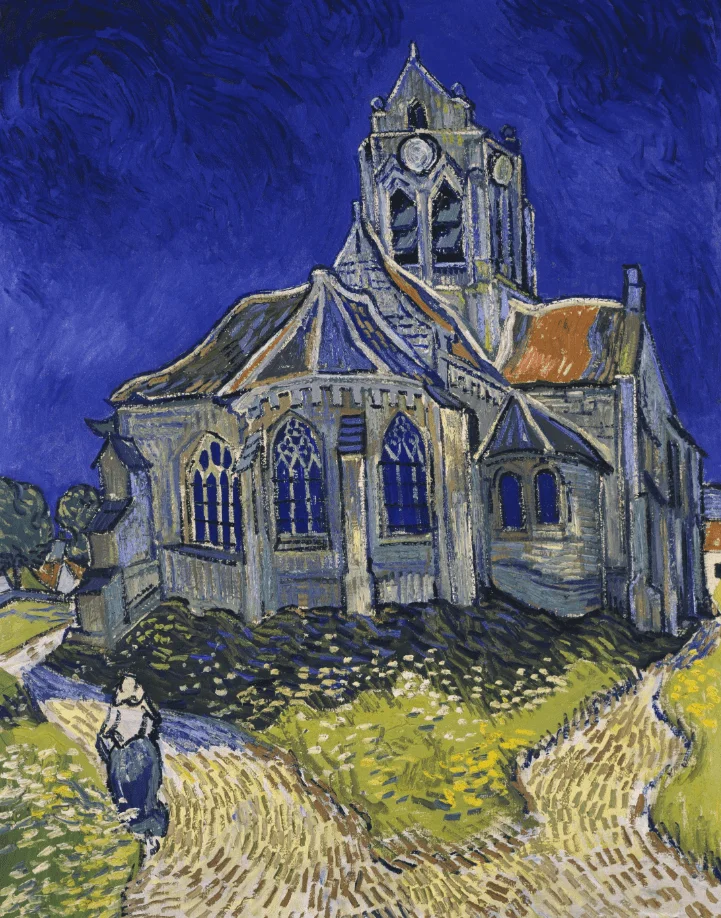
13. The Night Café
- Date created: 1888
- Location: Yale University Art Gallery, New Haven, United States
- Dimensions: 72.4 × 92.1 centimeters – 28.5 × 36.3 inches
The Night Café has its title inscribed in the lower right corner of the painting, just below the painting’s signature. It depicts the interior of “Café de la Gare” at 30, Place Lamartine, in Arles. It was painted in September 1888.
The owner of the Café was Joseph-Michel Ginoux. His wife Marie would later pose for a painting created by both van Gogh and Gauguin called “l’Arlésienne,” which means “the woman from Arles.” Gauguin would eventually create a competition piece that depicts a completely different and more vibrant scene at the Café.
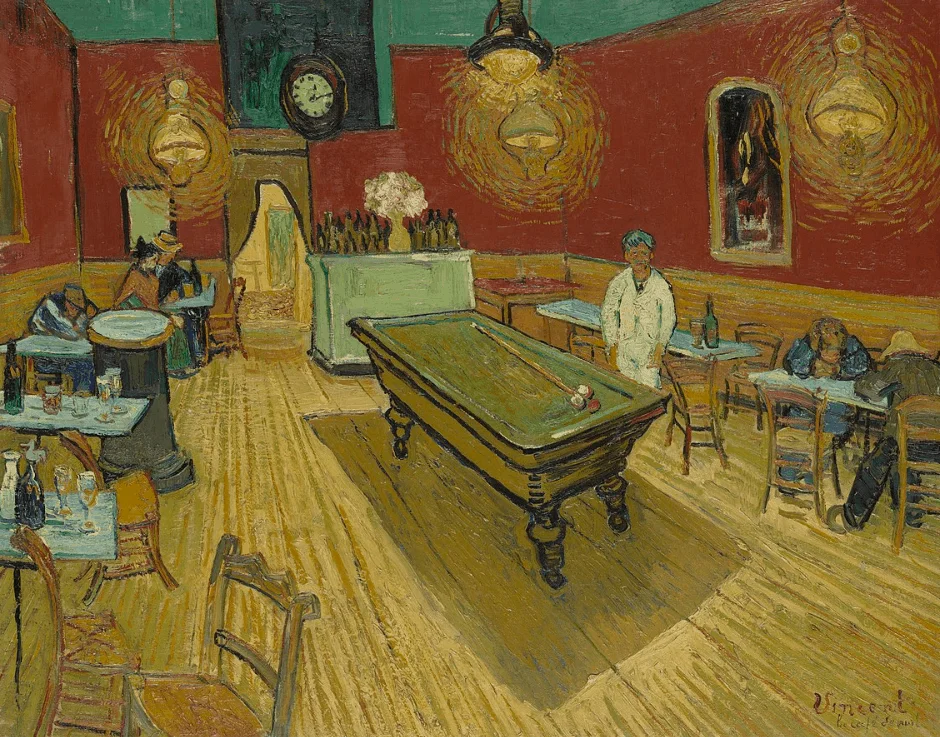
14. Self-Portrait with Bandaged Ear
- Date created: 1889
- Location: The Gallery at Somerset House, London, United Kingdom
- Dimensions: 60 × 49 centimeters – 24 × 19 inches
The Self-Portrait with Bandaged Ear is another self-portrait that depicts the state of van Gogh just after his psychotic episode in Arles. The visit of Paul Gauguin had culminated in an event in which Vincent had cut off part of his left ear and was rushed to the hospital the following day.
The event happened on December 23, 1888, and this painting was created the following month in January 1889. He painted his right ear as being in a bandage, even though he had cut his left because he used a mirror. The painting is now in the collection of the Courtauld Institute of Art and on display in London.
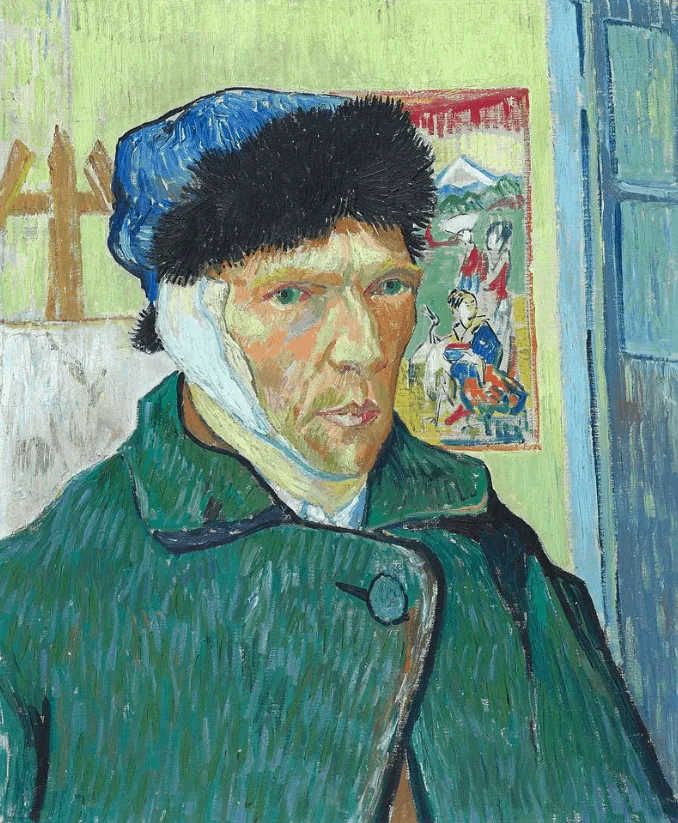
15. Tree Roots
- Date created: 1890
- Location: Van Gogh Museum, Amsterdam, Netherlands
- Dimensions: 50.0 × 100.0 centimeters – 19.7 × 40.6 inches
Tree Roots was painted in July of the year 1890 and is another painting that is suspected to have been his final painting. It was painted while he was living with Dr. Gachet in the small town of Auvers-Sur-Oise just north of Paris, after his period at the asylum in southern France.
It’s a fine example of the double-square canvases, which are canvases large in size than usual in which one side is double the size of the other, which he used in his final landscapes. It’s considered to be one of his most original paintings which became the predecessor of abstract paintings and German Expressionism.
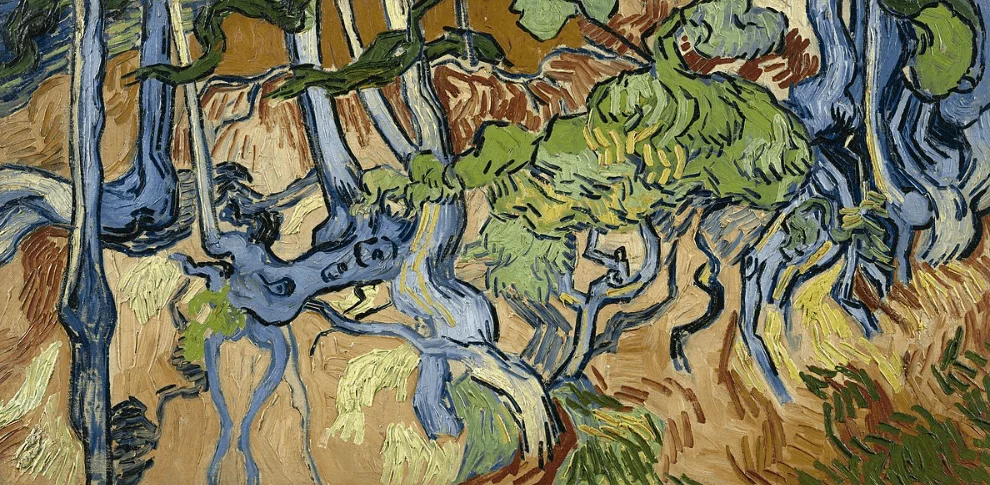
16. Bedroom in Arles
- Date created: 1888-1889
- Dimensions: 72 × 90 centimeters (28.3 × 35.4 inches) / 57 x 74 centimeters (22.44 x 29.13 inches).
- Location: The Van Gogh Museum / Art Institute of Chicago / Musée d’Orsay
Bedroom in Arles is the title of three different paintings with the same subject that van Gogh produced in October 1888 (version 1) and September 1889 (versions 1 and 2). It depicts his bedroom on the second floor of the Yellow House in Arles, the small city he lived in for over a year.
The second version was produced in September 1889 because the first one was a bit damaged. The third version was chosen by the artist for slightly smaller reproductions of his best works. Only the genius of Vincent van Gogh could transform a simple bedroom into one of the most iconic paintings ever produced.
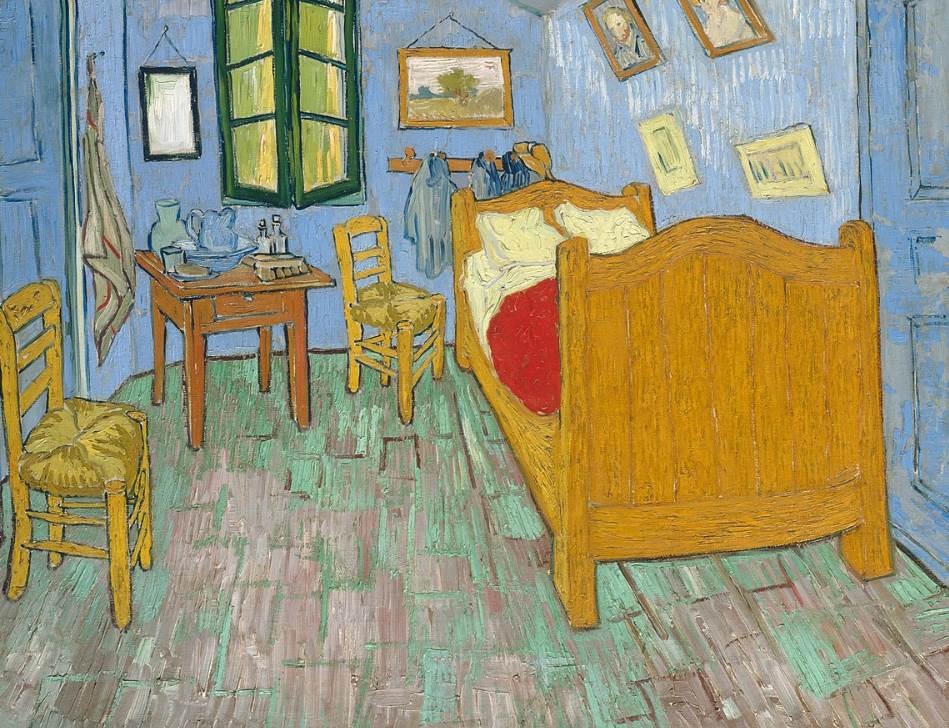
17. Green Wheat Field with Cypress
- Date created: June 1889
- Dimensions: 73 × 92.5 centimeters (29 × 36.4 inches)
- Location: National Gallery Prague, Prague, Czech Republic
Green Wheat Field with Cypress is one of many paintings in the oeuvre of Vincent van Gogh that depict wheat fields and cypresses. Many of these depict the scenery just outside of the Asylum of Saint-Paul just outside of Saint-Rémy where he stayed for an extended period of time.
This famous green painting has a calm and tranquil composition which is in sheer contrast to the chaotic paintings he produced during the final phase of his life. He was allowed to make short trips outside of the asylum at the time so it’s likely that his mood was pretty good at the time.



